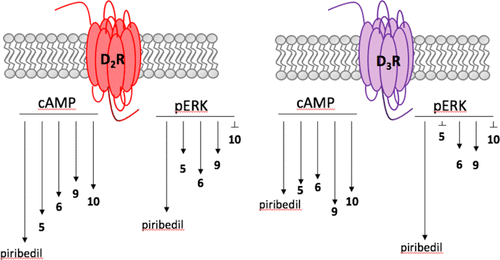Our official English website, www.x-mol.net, welcomes your
feedback! (Note: you will need to create a separate account there.)
Identification of a Tool Compound to Study the Mechanisms of Functional Selectivity between D2 and D3 Dopamine Receptors
ACS Omega ( IF 3.7 ) Pub Date : 2018-12-14 00:00:00 , DOI: 10.1021/acsomega.8b02509 Irene Reyes-Resina 1, 2 , Abdelouahid Samadi 3 , Gemma Navarro 1, 4 , Haythem A. Saadeh 3, 5 , Mohammad A. Khasawneh 3 , Jordi Mestres 6 , José Marco-Contelles 7 , Rafael Franco 1, 2
ACS Omega ( IF 3.7 ) Pub Date : 2018-12-14 00:00:00 , DOI: 10.1021/acsomega.8b02509 Irene Reyes-Resina 1, 2 , Abdelouahid Samadi 3 , Gemma Navarro 1, 4 , Haythem A. Saadeh 3, 5 , Mohammad A. Khasawneh 3 , Jordi Mestres 6 , José Marco-Contelles 7 , Rafael Franco 1, 2
Affiliation

|
The search for synthetic selective compounds for G-protein-coupled receptors has provided a myriad of molecules with high selectivity and therapeutic potential. In some cases, however, selectivity is difficult to obtain. For instance, the selectivity ratio is relatively low for compounds acting on D2 and D3 dopamine receptors, which are targets of neurodegenerative diseases such as Parkinson’s and Huntington’s. From a therapeutic point of view, it is of interest the relative recent discovery of biased agonism, which is characterized by different signaling pathways engaged by different compounds acting on a given receptor. The aim of this paper was to investigate whether new piribedil-derived compounds could display higher selectivity for D2 or D3 receptor and/or provide biased signaling. The results show that selectivity was not different, but that one of the molecules described here, 5-((4-(pyrimidin-2-yl)piperazin-1-yl)methyl)quinolin-8-ol (10), does engage Gi-mediated signaling via D2 or D3 receptors, whereas it does not activate the mitogen-activated-protein kinase pathway, which is usually activated by dopamine receptor agonists.
中文翻译:

鉴定用于研究D 2和D 3多巴胺受体之间功能选择性机理的工具化合物
对G蛋白偶联受体的合成选择性化合物的研究提供了无数具有高选择性和治疗潜力的分子。然而,在某些情况下,很难获得选择性。例如,对于作用于D 2和D 3多巴胺受体的化合物的选择性比率相对较低,D 2和D 3多巴胺受体是帕金森氏病和亨廷顿氏病等神经退行性疾病的靶标。从治疗的观点来看,引起人们关注的是相对最新的偏向激动作用的发现,其特征在于作用在给定受体上的不同化合物所参与的信号通路不同。本文的目的是研究新的吡吡贝德类化合物能否对D 2或D 3表现出更高的选择性。受体和/或提供偏向信号。结果表明选择性没有不同,但此处所述的一种分子5-((4-(嘧啶-2-基)哌嗪-1-基)甲基)喹啉-8-ol(10)确实参与了Gi通过D 2或D 3受体介导的信号传导,而它不激活通常通过多巴胺受体激动剂激活的有丝分裂原激活的蛋白激酶途径。
更新日期:2018-12-14
中文翻译:

鉴定用于研究D 2和D 3多巴胺受体之间功能选择性机理的工具化合物
对G蛋白偶联受体的合成选择性化合物的研究提供了无数具有高选择性和治疗潜力的分子。然而,在某些情况下,很难获得选择性。例如,对于作用于D 2和D 3多巴胺受体的化合物的选择性比率相对较低,D 2和D 3多巴胺受体是帕金森氏病和亨廷顿氏病等神经退行性疾病的靶标。从治疗的观点来看,引起人们关注的是相对最新的偏向激动作用的发现,其特征在于作用在给定受体上的不同化合物所参与的信号通路不同。本文的目的是研究新的吡吡贝德类化合物能否对D 2或D 3表现出更高的选择性。受体和/或提供偏向信号。结果表明选择性没有不同,但此处所述的一种分子5-((4-(嘧啶-2-基)哌嗪-1-基)甲基)喹啉-8-ol(10)确实参与了Gi通过D 2或D 3受体介导的信号传导,而它不激活通常通过多巴胺受体激动剂激活的有丝分裂原激活的蛋白激酶途径。











































 京公网安备 11010802027423号
京公网安备 11010802027423号